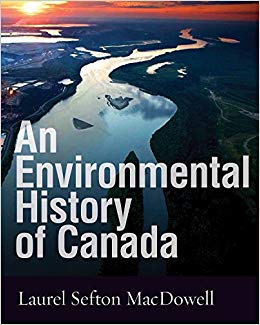An Environmental History of Canada
Review By Sterling Evans
October 26, 2013
BC Studies no. 178 Summer 2013 | p. 121-122
 On the growing list of books on Canadian environmental history, University of Toronto historian Laurel MacDowell’s new textbook An Environmental History of Canada should take a prominent place. The evolution of this field of study indicates both a rapidly maturing branch of history and the need for a solid textbook for undergraduate upper division courses. Along with the first book in the field, Consuming Canada: Readings in Environmental History (1995), edited by Chad Gaffield and Pam Gaffield, and then David Freeland Duke’s edited volume Canadian Environmental History: Essential Readings (2006) — which is essentially more like a nicely arranged course packet — and Graeme Wynn’s Canada and Arctic North America: An Environmental History (2007), we can now add MacDowell’s fine textbook, An Environmental History of Canada. I would heartily recommend it be adopted, and I suspect it will be in high demand.
On the growing list of books on Canadian environmental history, University of Toronto historian Laurel MacDowell’s new textbook An Environmental History of Canada should take a prominent place. The evolution of this field of study indicates both a rapidly maturing branch of history and the need for a solid textbook for undergraduate upper division courses. Along with the first book in the field, Consuming Canada: Readings in Environmental History (1995), edited by Chad Gaffield and Pam Gaffield, and then David Freeland Duke’s edited volume Canadian Environmental History: Essential Readings (2006) — which is essentially more like a nicely arranged course packet — and Graeme Wynn’s Canada and Arctic North America: An Environmental History (2007), we can now add MacDowell’s fine textbook, An Environmental History of Canada. I would heartily recommend it be adopted, and I suspect it will be in high demand.
After a short, but essential, introduction regarding definitions and directions in environmental history, MacDowell divides the textbook into four parts. The first, “Aboriginal Peoples and Settlers,” has a couple of chapters on “Encountering a New Land” and “Settling the Land and Transforming the ‘Wilderness.’” Part 2 treats various facets of “Industrialism, Reform, and Infrastructure” that includes topics on urban history, conservation, mining, and consumerism. The third part, “Harnessing Nature, Harming Nature,” examines the important topics of energy, water, and food/agriculture. The final part is entitled “The Environmental Era.” It has chapters on the Canadian environmental movement, parks and wildlife, coastal fisheries, and the North and climate change. Each chapter ends with an excellent listing of important works in the topics covered (nicely divided into subtopical fields) — an extremely useful tool for students. A conclusion rounds out the textbook, but it is rather short at only four pages and perhaps could have been expanded to tie together thematically some of the various dimensions of Canadian environmental history dealt with throughout the book. But then again, how many undergrads actually read conclusions?
A word about style and layout: Both MacDowell and UBC Press should be congratulated for designing a model textbook. It is loaded with scores of excellent illustrations and photos, has in every chapter a variety of engaging sidebar stories (although some readers might find some of these to be a bit too short and superficial), and makes use of a plenty of maps, graphs, and diagrams. The map on Canada’s ecological regions (42), however, should have appeared earlier in the book to provide some geographical context, and should have been reproduced in a larger and more colourful format. But all of these features make for an enjoyable reading experience, breaking up the narrative and providing a great many points of departure for classroom discussions. And unlike Consuming Canada or Canadian Environmental History, MacDowell’s book thankfully delves deep into twentieth and twenty-first century topics, especially in terms of natural resources and environmental politics and activism. Without being too presentist, those more current issues are important for students to understand, especially with the historical grounding provided in the book and with corresponding lectures. As MacDowell explains the goal of the book, “this environmental history of Canada brings to light the grave consequences of the development ethos as it played out in Canadian history, not to condemn, but so we can develop strategies to create a livable, sustainable environment in the future” (6).
Some scholars south of the forty-ninth parallel may wonder how this text differs from counterparts in American environmental history. MacDowell explains right off that Canada “has a different climate, distinctive geographical features, such as the Canadian Shield, its own history, a parliamentary system of government and politics, and unique elements such as Crown lands…”(4). These points are well taken, especially with her chapters on coastal fisheries and environmental history of the far North. Thus, instructors in the United States could value from adding this textbook to their own courses on North American environmental history — a welcome trend to see things more continentally. And if they find themselves a bit behind on their knowledge of Canadian history, adopting this text will fill in the gaps, and will be of essential use for professor and student alike.
An Environmental History of Canada
By Laurel Sefton MacDowell
Vancouver: UBC Press, 2012. 352 pp, $49.95 paper
